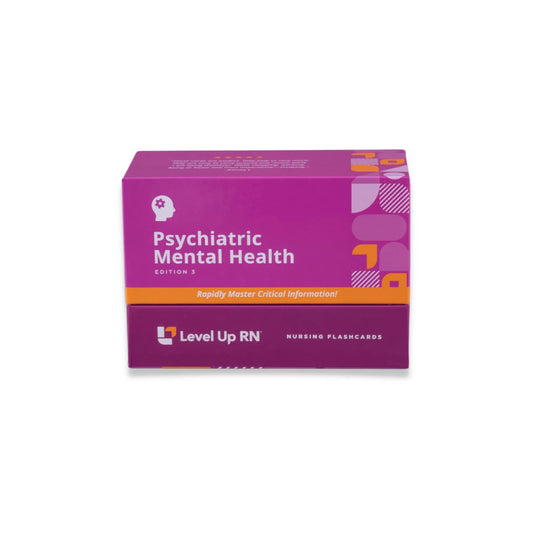Psychiatric Mental Health - Nursing Flashcards
In this article, we cover relaxation techniques, milieu therapy, group therapy, and different types of behavioral therapy.
This series follows along with our Psychiatric Mental Health Nursing Flashcards which are intended to help RN and PN nursing students study for nursing school exams, including the ATI, HESI, and NCLEX.
Relaxation techniques
Relaxation techniques promote relaxation for the patient, and can include progressive relaxation, biofeedback, guided imagery, meditation, and others.
Progressive Relaxation
Progressive relaxation is the tightening and relaxing of muscle groups in a systematic order to relieve stress and tension.
Biofeedback
Biofeedback uses a device to monitor the patient's body vital signs with a goal of obtaining voluntary control over them.
Guided Imagery
Guided imagery is a relaxation technique involving visualizing detailed images to promote relaxation.
Meditation
Meditation is a relaxation technique involving mind and body practice where an individual focuses on a word or sensation (like breathing) to improve health and well-being.
Others
Other relaxation techniques include deep breathing, self-hypnosis, yoga, tai chi, and others.
Milieu Therapy
The milieu in milieu therapy refers to the environment. Milieu therapy aims to structure the physical environment to bring about beneficial changes to a person's mental health and behavior.
Goals
The goal of milieu therapy is to maintain a therapeutic environment. This type of therapy teaches patients beneficial coping, relationship, and interactive skills that can be applied to their daily lives. The idea is to promote and maintain client autonomy.
Key concepts
The key concepts of milieu therapy are containment, validation, structured interaction, and open communication.
Containment
Containment in milieu therapy is providing for the safety and security of the patient, along with providing privacy where possible.
Validation
Validation in milieu therapy places emphasis on a patient's worth and dignity.
Structured interaction
Structured interaction in milieu therapy allows clients to interact with others in a meaningful way.
Open communication
Milieu therapy's open communication encourages purposeful self-disclosure by the patient with the staff.
Group Therapy
Group therapy is therapy that is carried out in a group setting that provides members with socialization, support, and/or education.
Phases
The phases of group therapy include orientation, working, and termination.
Orientation
The orientation phase of group therapy helps to facilitate introductions, define the purpose of the group, and discuss rules and confidentiality.
Working
The working phase of group therapy is the phase during which most of the work of therapy is accomplished. The leader refocuses the group as needed and helps to resolve conflict.
Termination
The termination phase of group therapy is the end of group therapy. To the patient, this may be viewed as a loss and can bring about feelings of grief.
Member Roles
There are several member roles to be aware of in group therapy, including task roles, maintenance roles, and individual roles.
Task Roles
When a patient is assuming a task role in group therapy, they contribute directly to the group’s completion of a task or defined goal (e.g., a group therapy coordinator).
Maintenance Roles
When a patient takes a maintenance role in group therapy, they help to maintain social cohesiveness of the group — they are someone who harmonizes the group.
Individual Roles
A patient's individual role in group therapy satisfies their needs as an individual member, but may interfere with effectiveness of the group. For example, if someone is dominating the group, they may feel that their needs have been met, but this may harm group effectiveness.
Behavioral Therapy
Behavioral therapy includes operant conditioning, modeling, aversion therapy, systematic desensitization, and flooding.
Operant Conditioning
Operant conditioning uses positive reinforcement of desired behaviors.
Modeling
In modeling therapy, a patient learns new behaviors by imitating others. The therapist uses role-play to demonstrate appropriate behavior for the patient, then asks the patient to imitate that behavior.
Aversion Therapy
In aversion therapy, a negative stimulus is paired with an unwanted behavior to create a repulsion to that behavior. One example of this is disulfiram, a maintenance medication for alcohol abuse, makes the patient feel very sick if they ingest alcohol. To learn more about this and other alcohol abuse medications, check out our Pharmacology Flashcards.
Systematic Desensitization
During systematic desensitization, a patient is gradually exposed to a phobia while engaging in learned relaxation techniques.
Flooding
During flooding therapy, a patient is exposed to their feared stimuli at full intensity for a prolonged period until it no longer causes anxiety.



1 comment
It would be nice if you could list the cards that would be associated with the content somewhere below the videos :)